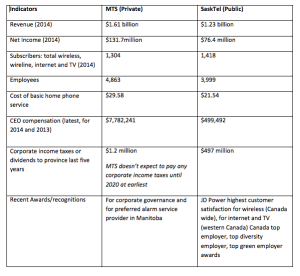By Toby Sanger, Senior Economist CUPE National
At a time when the Ontario Liberal government is planning to privatize Hydro One and other provincial governments are also planning significant privatizations, it’s instructive to look back and see what the impact of earlier privatizations has been.
There’s an excellent example right here in Canada of two neighbouring jurisdictions of a similar size, one of which privatized a utility and the other that kept its similar utility under public ownership. It should be seen as a cautionary tale and an indication of what is likely to happen with other privatizations.
That example is the telecom companies of Manitoba and Saskatchewan. These provinces have relatively similar populations—1.29 million in Manitoba and 1.13 million in Saskatchewan. Both provinces established publicly owned telephone companies at about the same time over a century ago.
The government of Manitoba bought Bell Canada’s Manitoba operations in 1908 and formed it into a publicly owned crown corporation that eventually became Manitoba Telephone System (MTS). Saskatchewan followed a year later in 1909 by buying the operations of Bell Canada and other private telephone companies in the province into a publicly owned operation that became SaskTel. Both eventually bought up all the private telephone operators in their provinces.
Both provinces operated successful parallel publicly-owned telephone systems in their respective provinces for almost ninety years until 1997. That was the year former Manitoba Progressive Conservative Premier Gary Filmon broke previous promises and privatized MTS, claiming that a private company would be more innovative. (Some of the sordid details that led to the privatization of MTS was detailed in an article in Canadian Dimension by Errol Black and Paula Mallea at that time). Meanwhile next door, SaskTel has remained the only government-owned telecommunications company, even after eight years of provincial rule under the conservative Saskatchewan Party.
It’s an understatement to say that there have been a lot of changes in the telecommunications industry since MTS was privatized, but 18 years later both MTS and SaskTel are generally similar sizes in terms of revenues, subscribers, types of services and number of employees relative to their populations. Both have had their share of technological and service advances, although the publicly owned SaskTel appears to have been more innovative than MTS, contrary to the claims that a private company would be more innovative.
And that’s about where the similarities end. It appears that the main priority of MTS is to satisfy their private shareholders, commercial customers, rewarding executives and promoting itself through advertising. Meanwhile SaskTel appears to focus on customer service and satisfaction, being a good employer and on providing returns to their public shareholder: the people of Saskatchewan.
As can be seen from the following table with key indicators for the two telcos, the cost of basic phone service through the publicly owned SaskTel is $8 per month or 27 percent lower than the lowest home phone service the MTS provides.
Together with higher fees to the public for its services, MTS generates higher revenues and about double the profit of SaskTel—but very little of the profits of MTS come back to the public (unless they happen to be its shareholders or executives). While SaskTel returned $497 million over the past five years back to the government and people of Saskatchewan through its annual dividend, MTS has paid corporate income taxes in only one year in the past ten years—and that was only $1.2 million in 2010. In all the other years, it has paid a big fat zero in federal and provincial corporate income taxes and it doesn’t expect to pay any income taxes until 2020 at the earliest because it is carrying forward hundreds of millions in expenses.
While MTS doesn’t provide any corporate income taxes back to the Canadian and Manitoba governments, it certainly doesn’t skimp when it comes to CEO compensation. In 2014, they paid their former CEO Pierre Blouin $7.8 million in total compensation. While that was a high, his average compensation over the past five years was $4.8 million, more than ten times what SaskTel’s CEO was paid, with MTS’s directors also paid more than ten times what SaskTel directors are paid.
What’s especially disturbing is that former Premier Gary Filmon, who privatized MTS after promising not to, personally profited from this action while the people of Manitoba lost out. Filmon was appointed to the MTS board shortly after he was defeated. He collected more than $1.4 million in director fees and compensation over ten years, with hundreds of thousands worth in shares.
None of this is meant to suggest that SaskTel is an ideal company, but it appears abundantly clear this publicly owned and operated company provides better service at lower costs to its customers than the privatized MTS, and it also provides much larger benefits to the people of the province from its profits. Despite all this, the Saskatchewan government may be laying the groundwork for privatization of SaskTel, as the CCPA’ Sask’s Simon Enoch has outlined.
If this is what we can expect from the privatizations of other public utilities—higher fees for the public, lower quality service, much higher compensation for CEOs and executives, higher corporate profits but much lower returns for the provinces—we can see why Bay Street is so excited about the privatization of Hydro One –and why the people of Ontario should be very worried.

Sources include the latest annual reports of Sasktel and MTS Allstream, Saskatchewan Payee Disclosure Report and MTS Management Information Circular.



